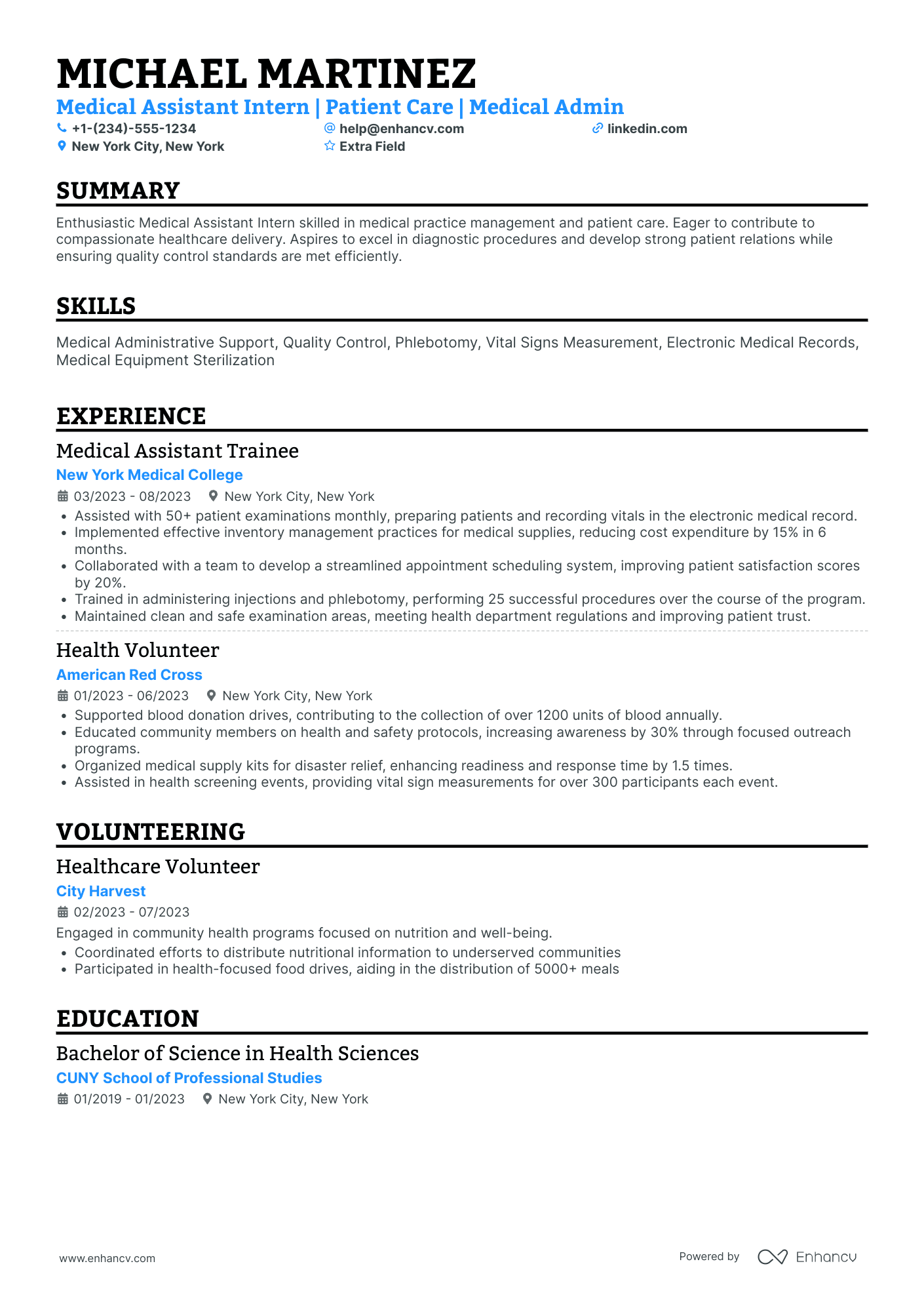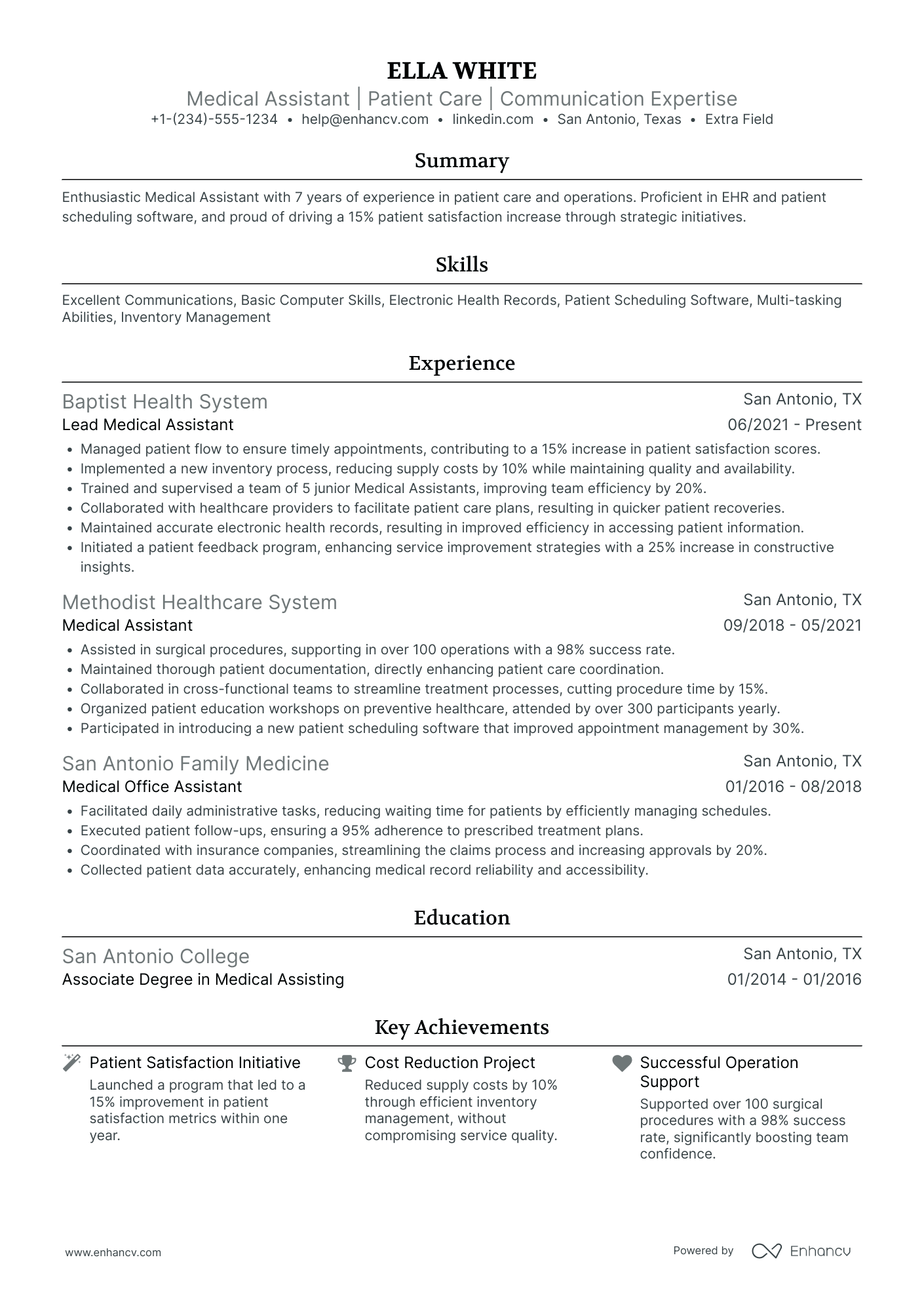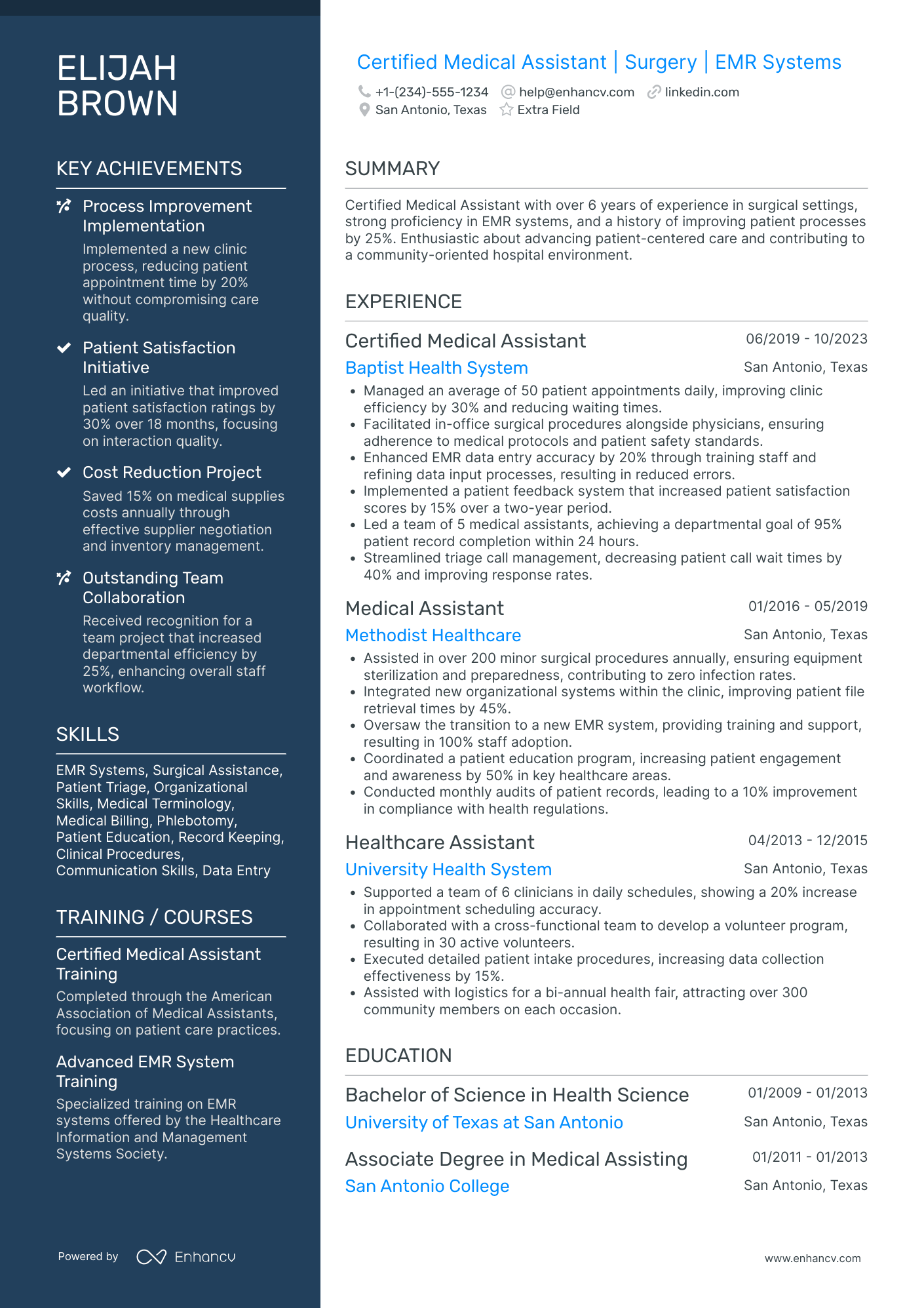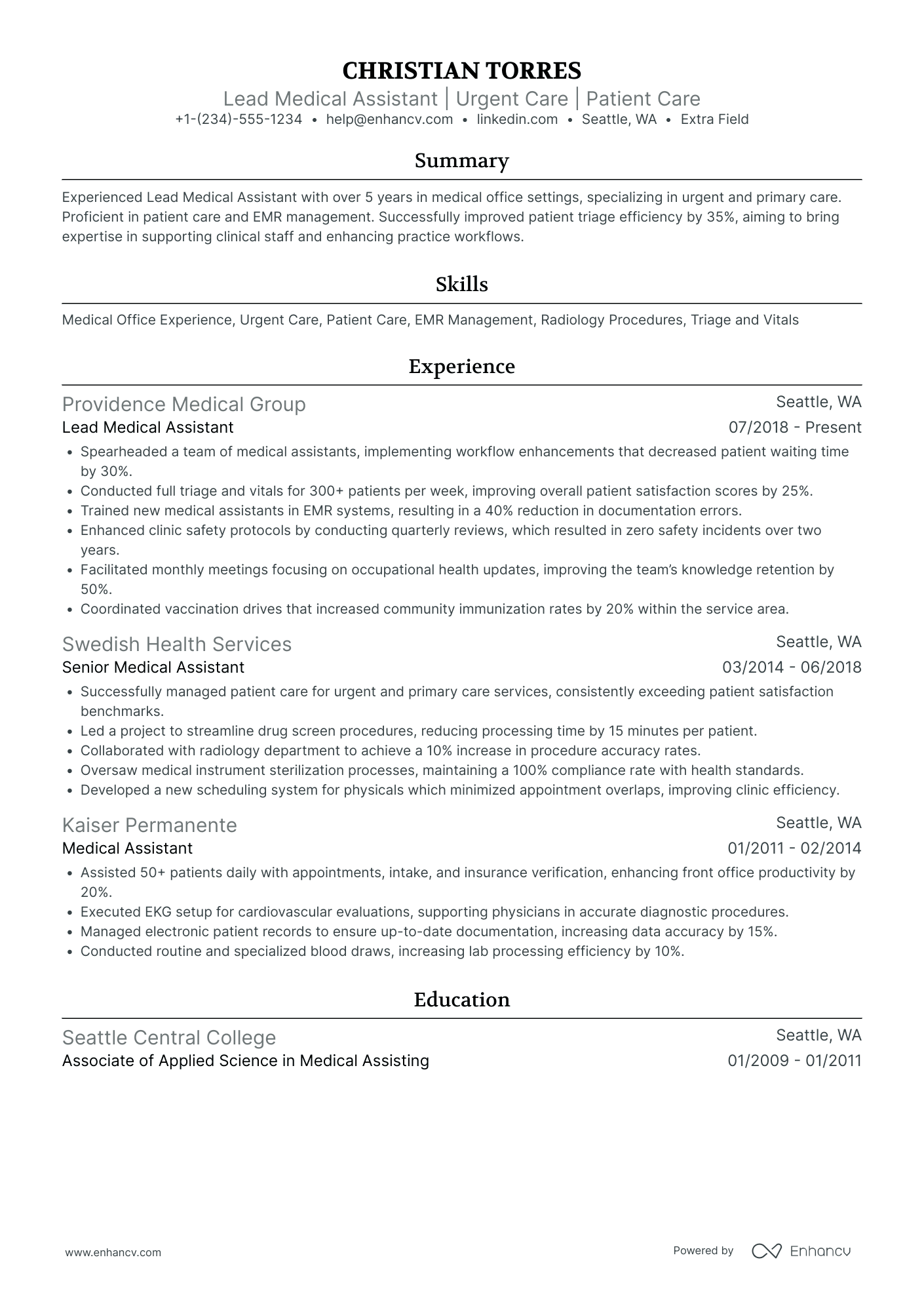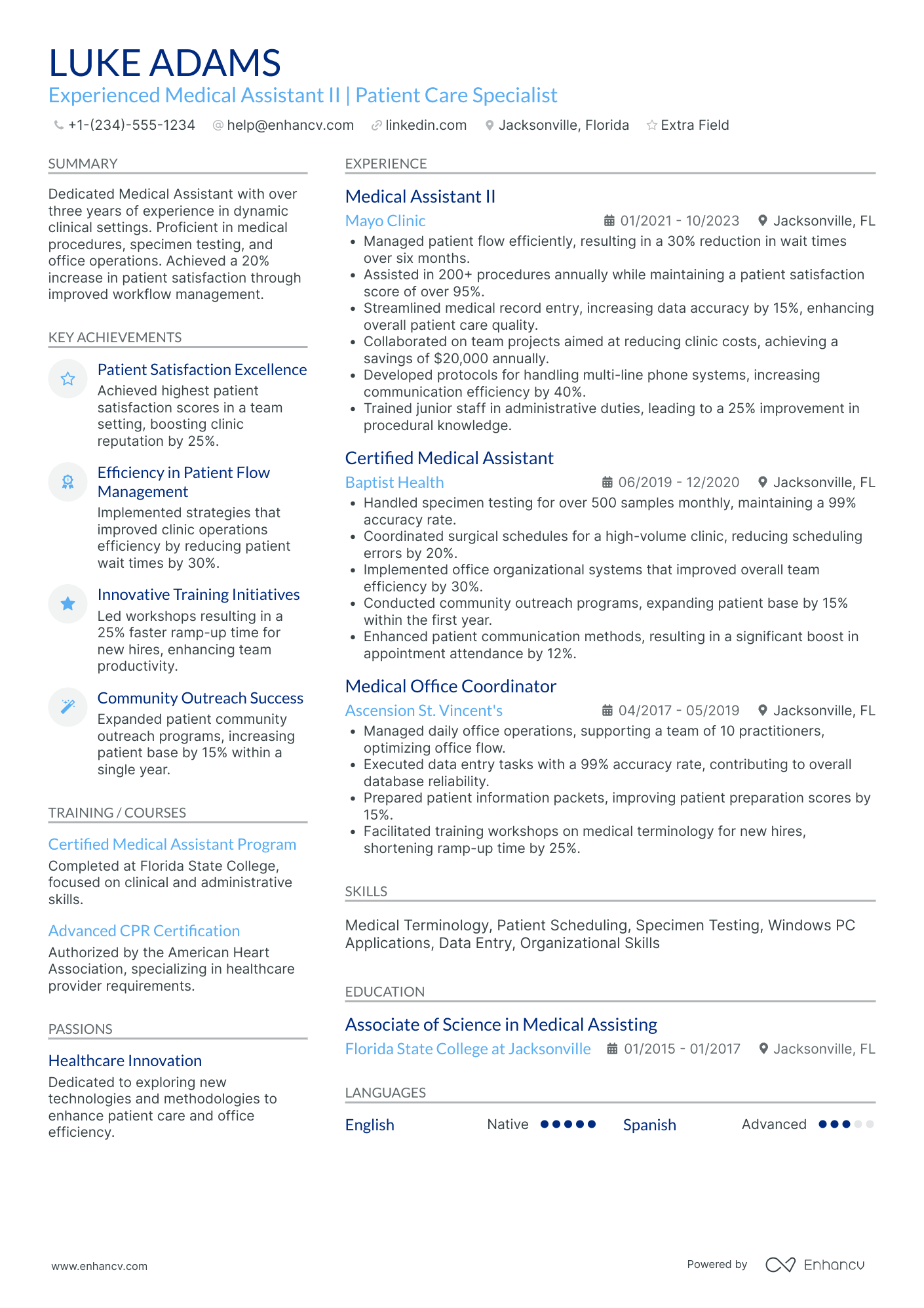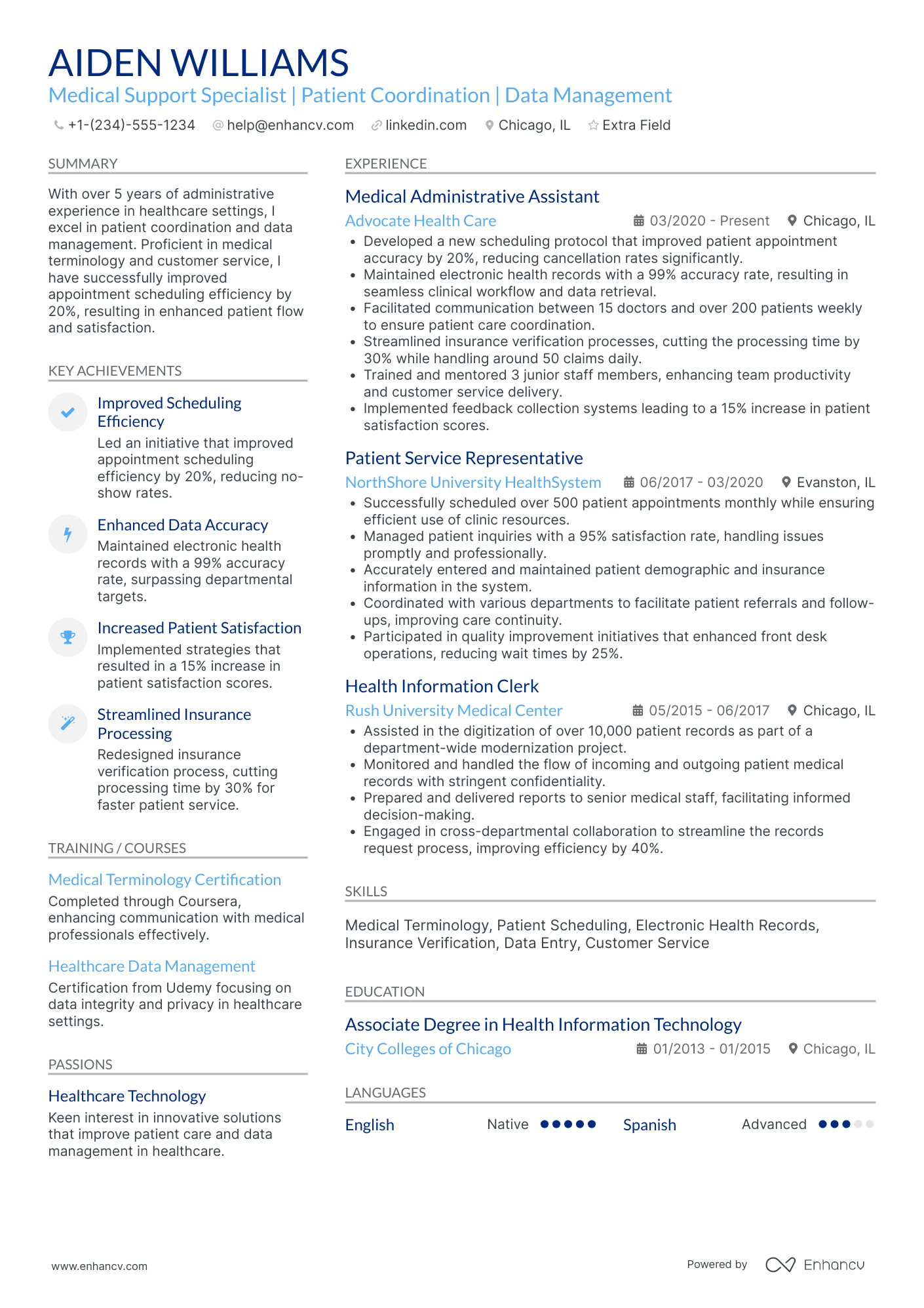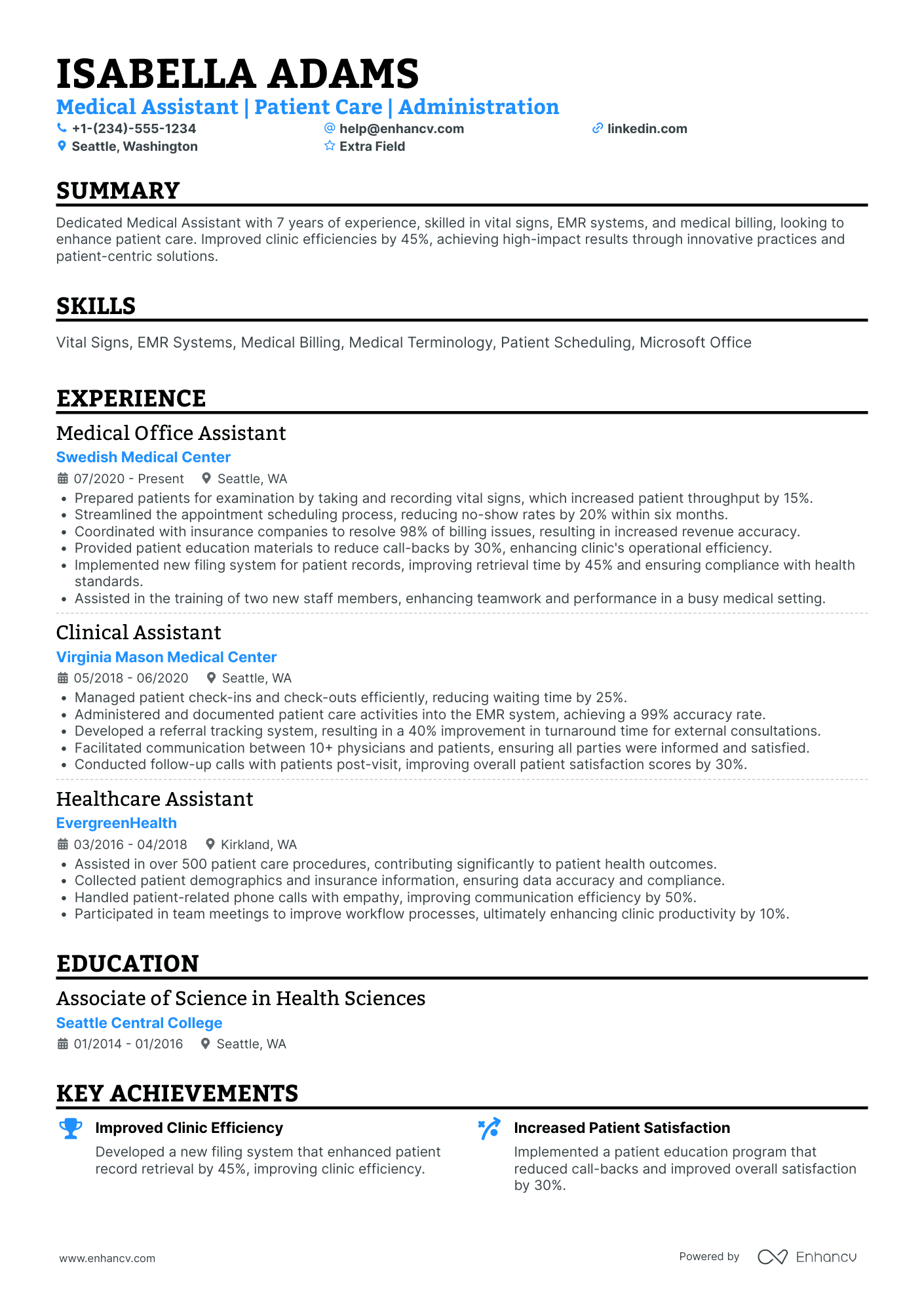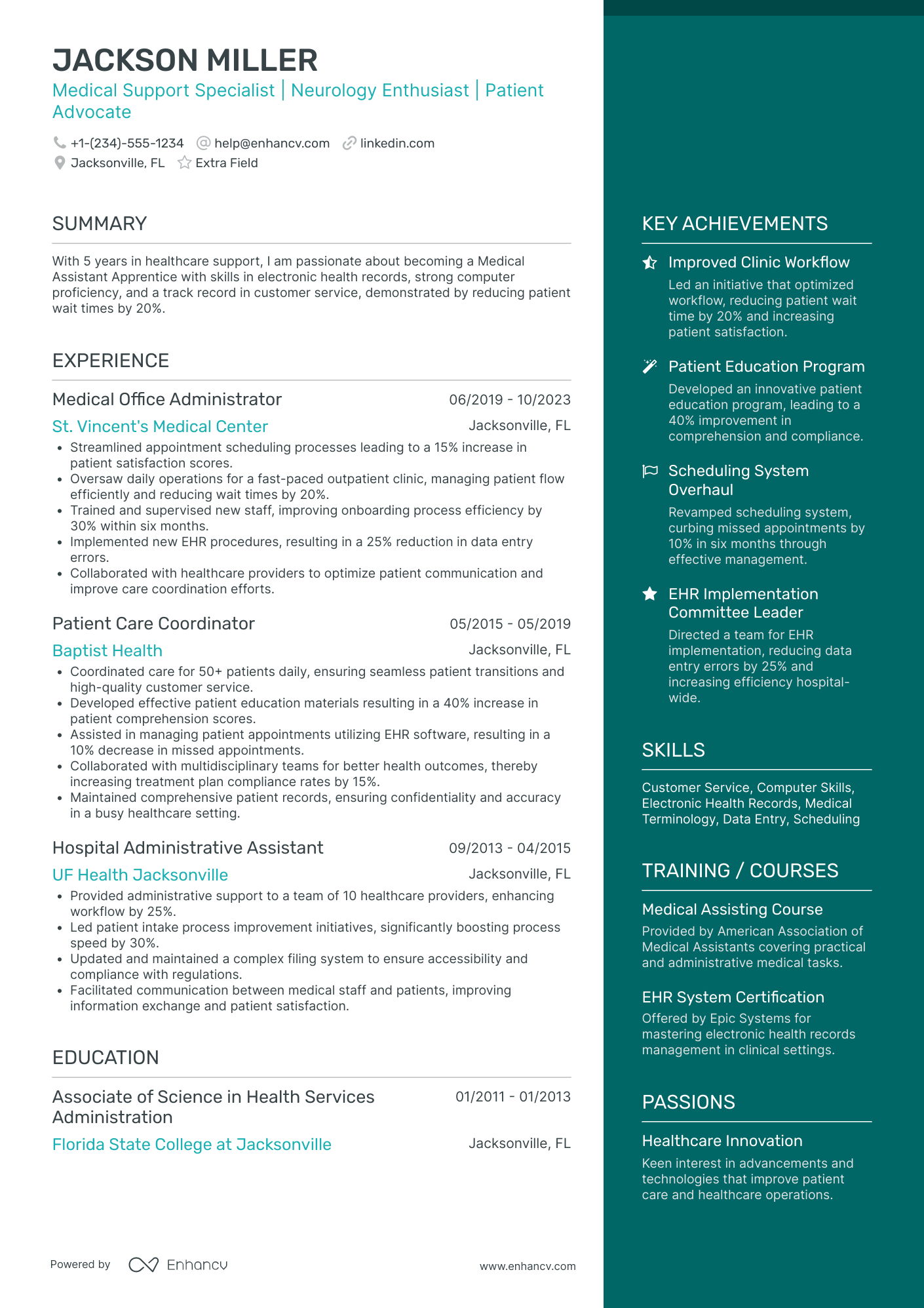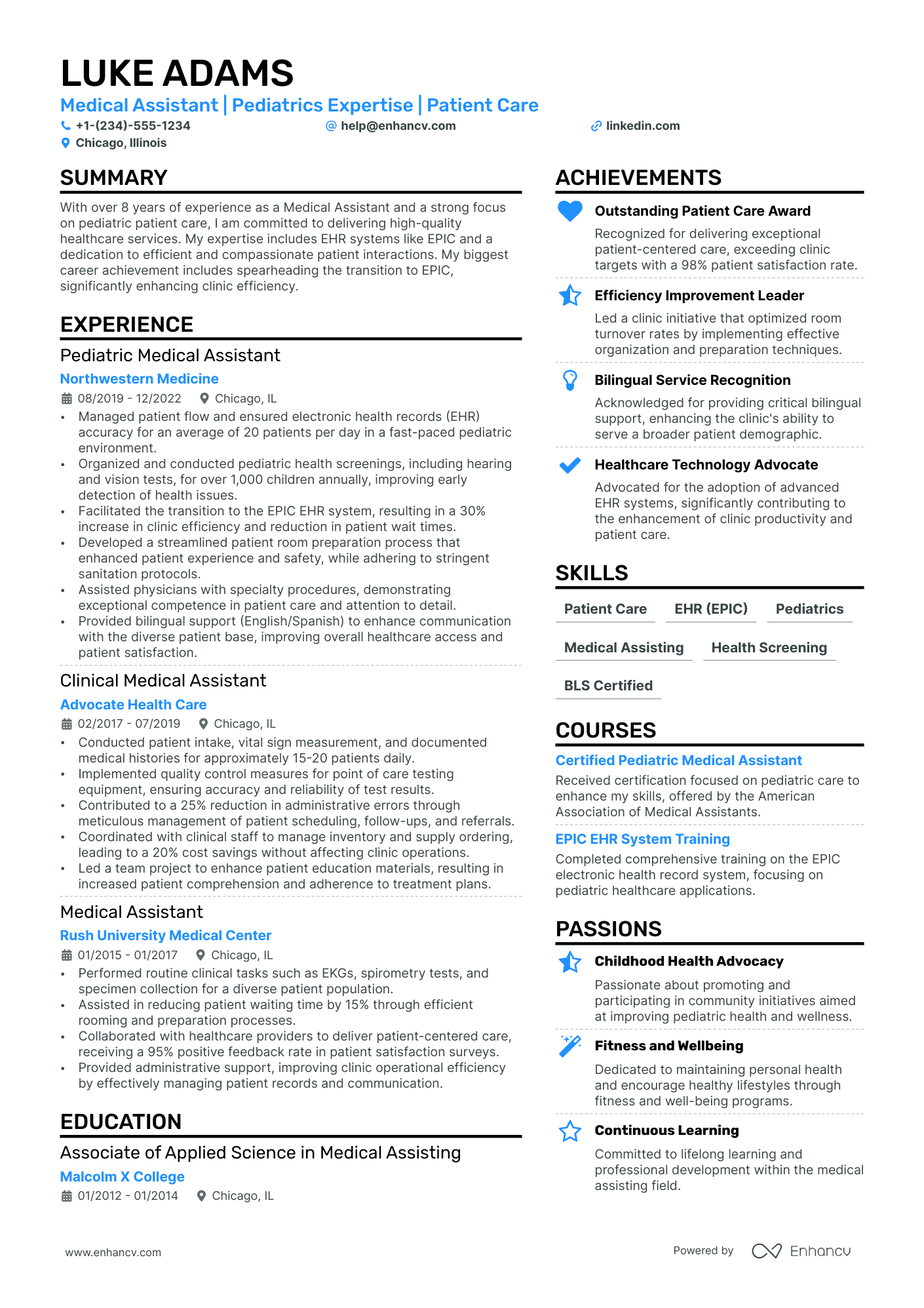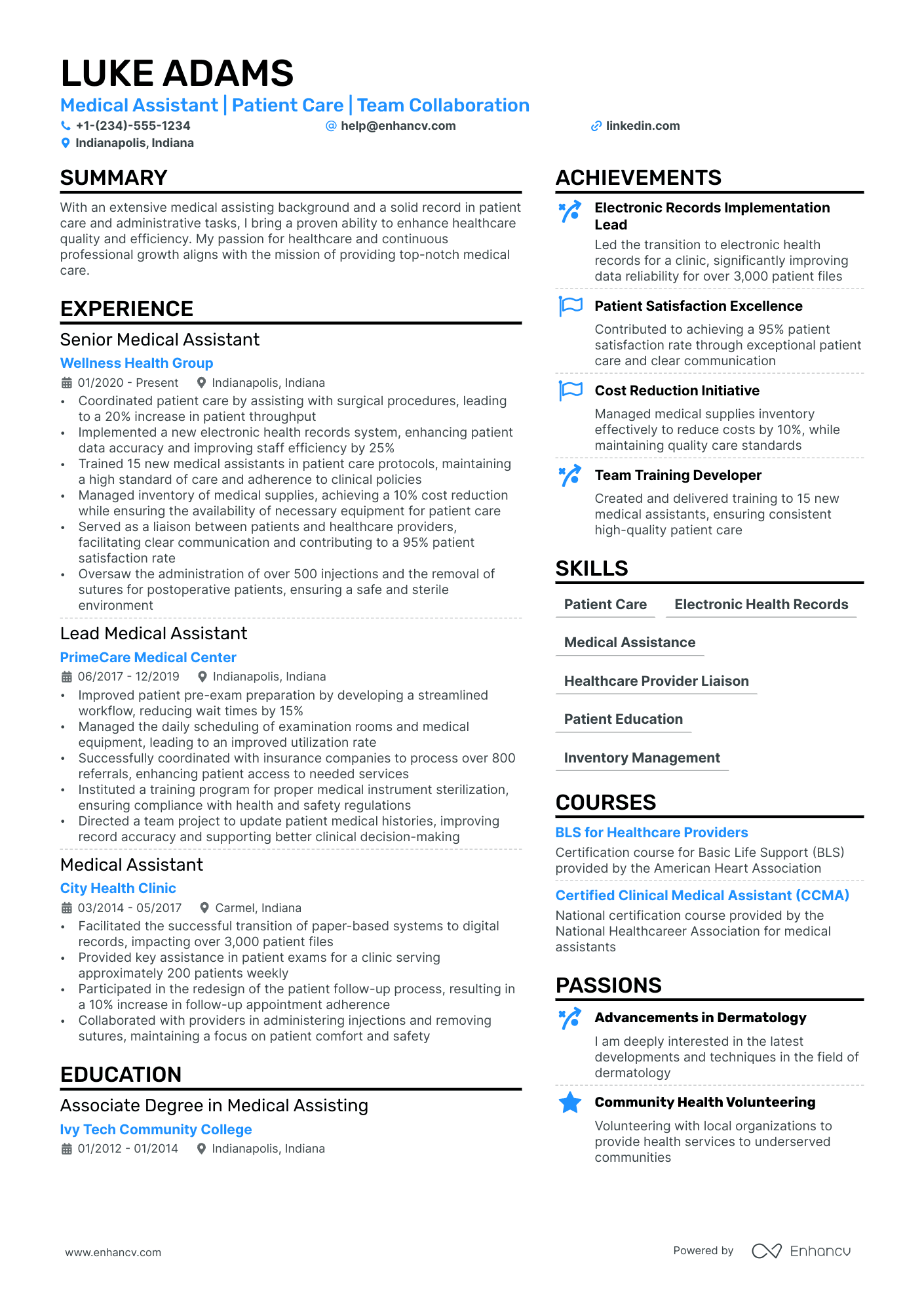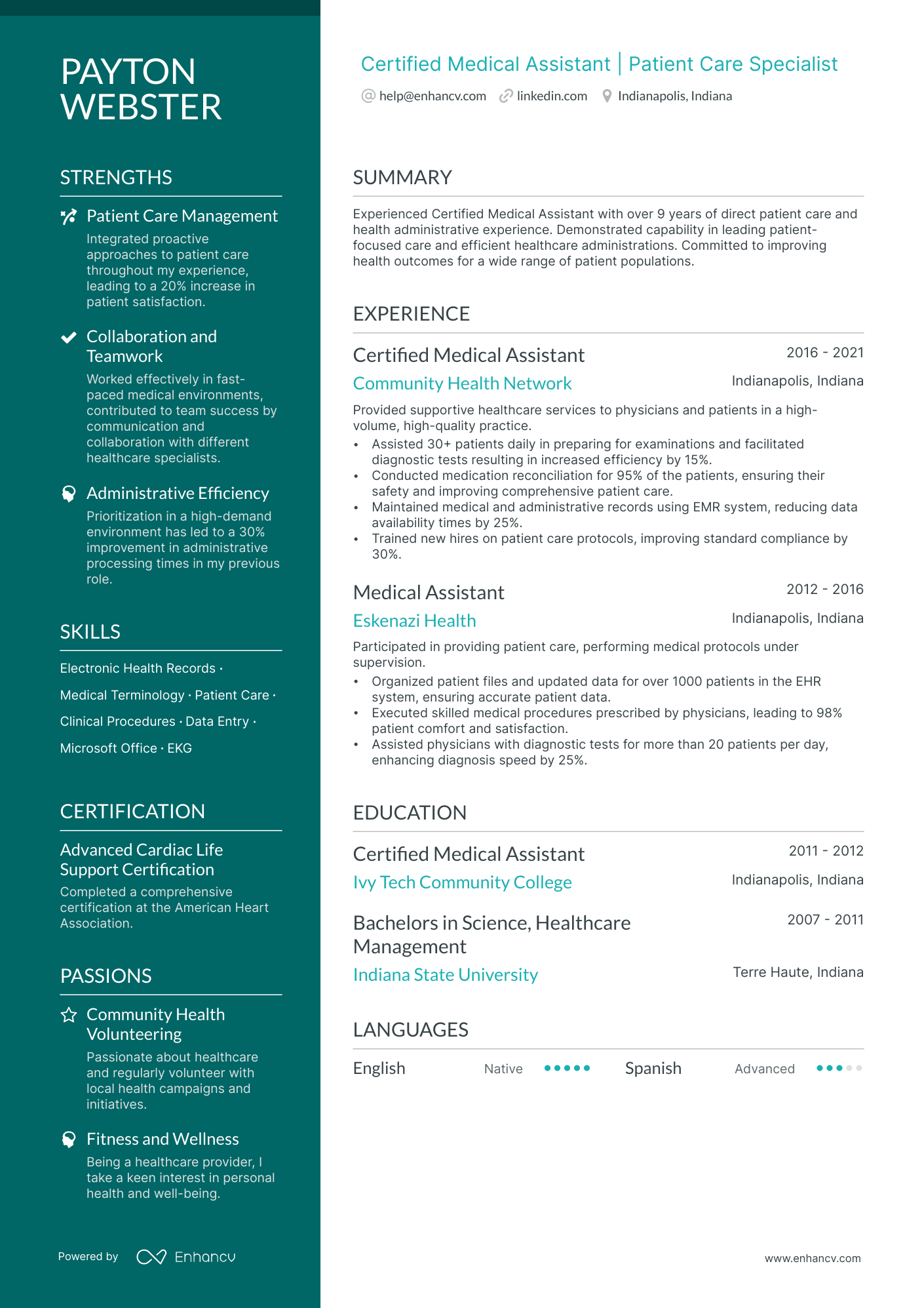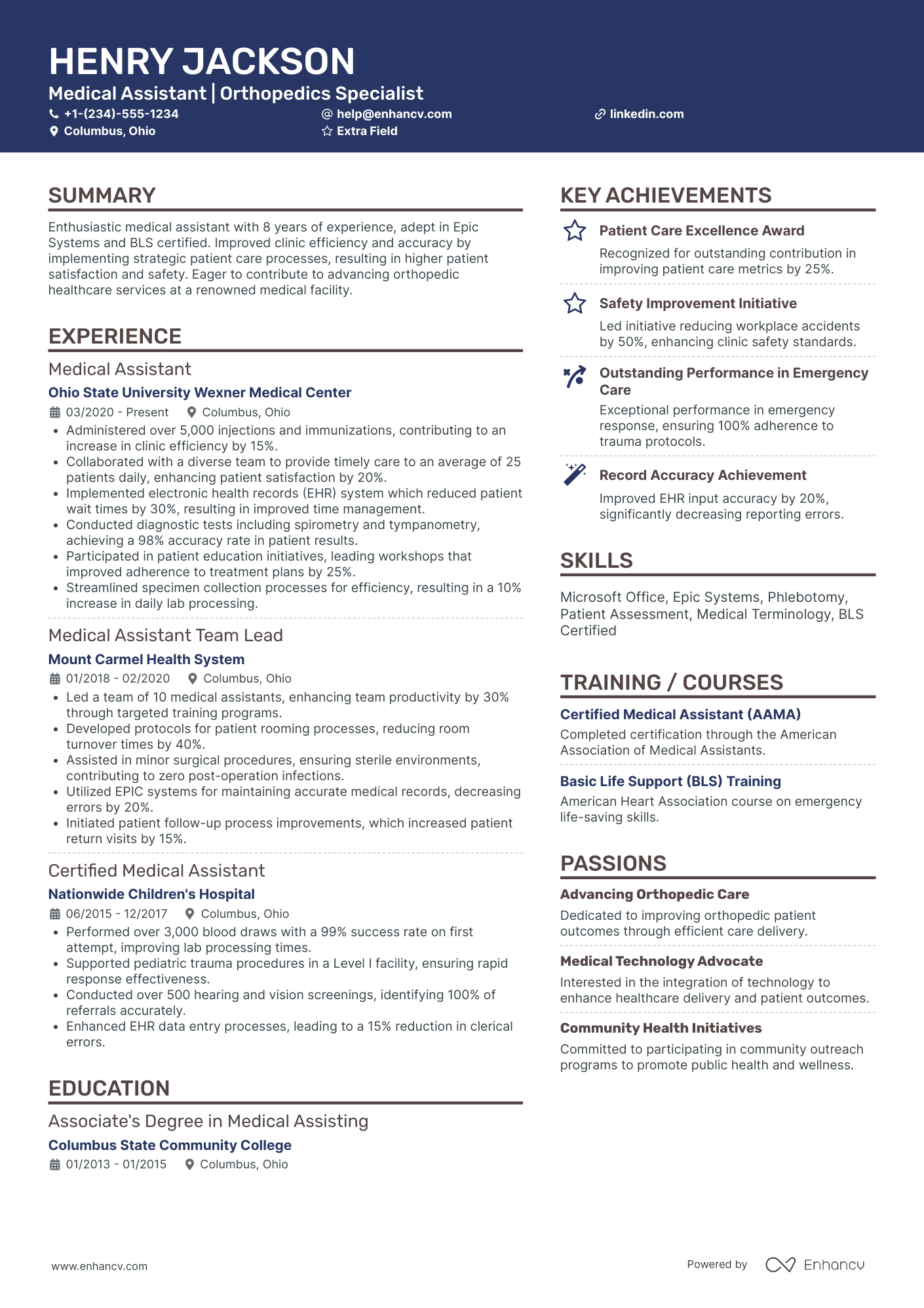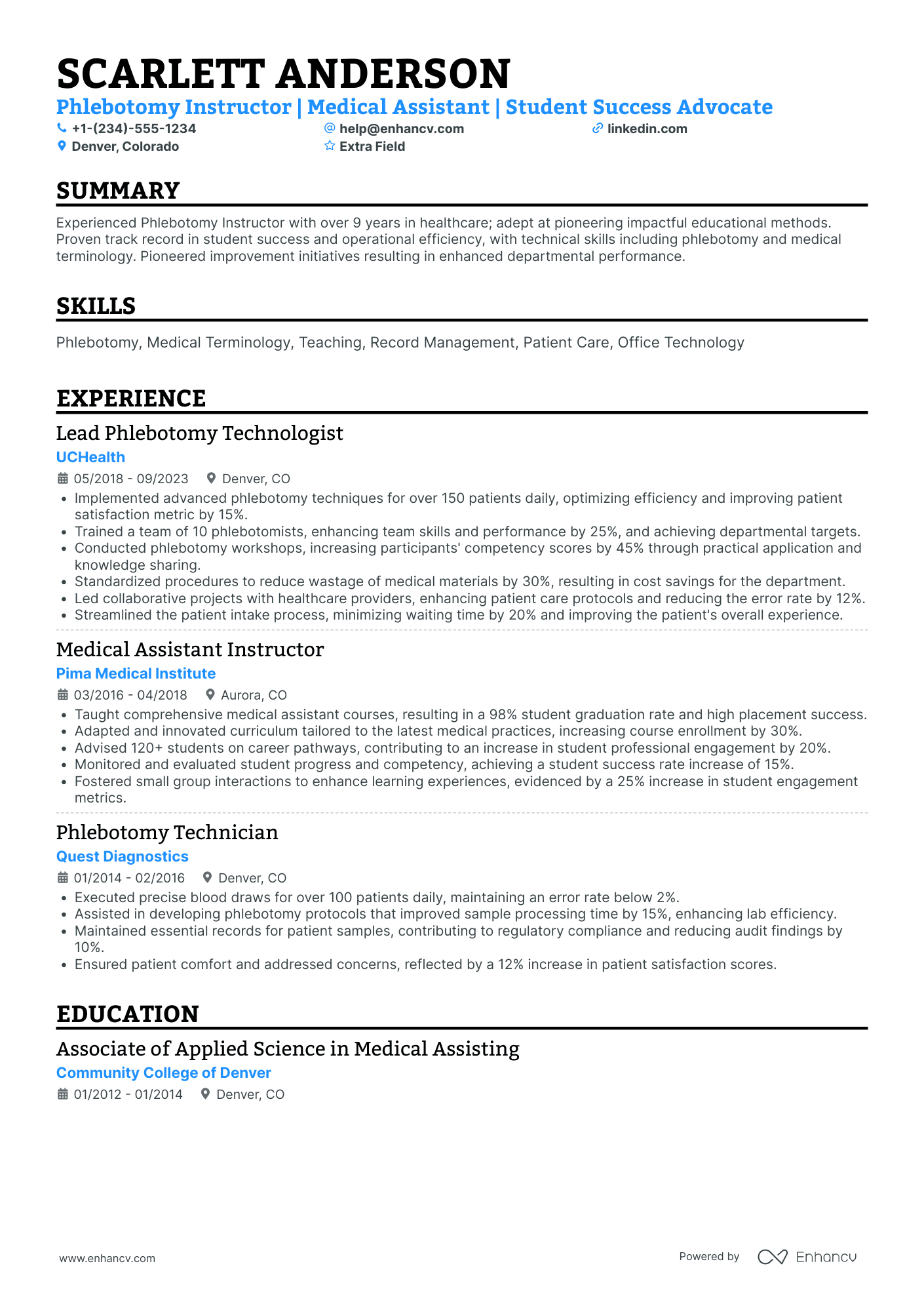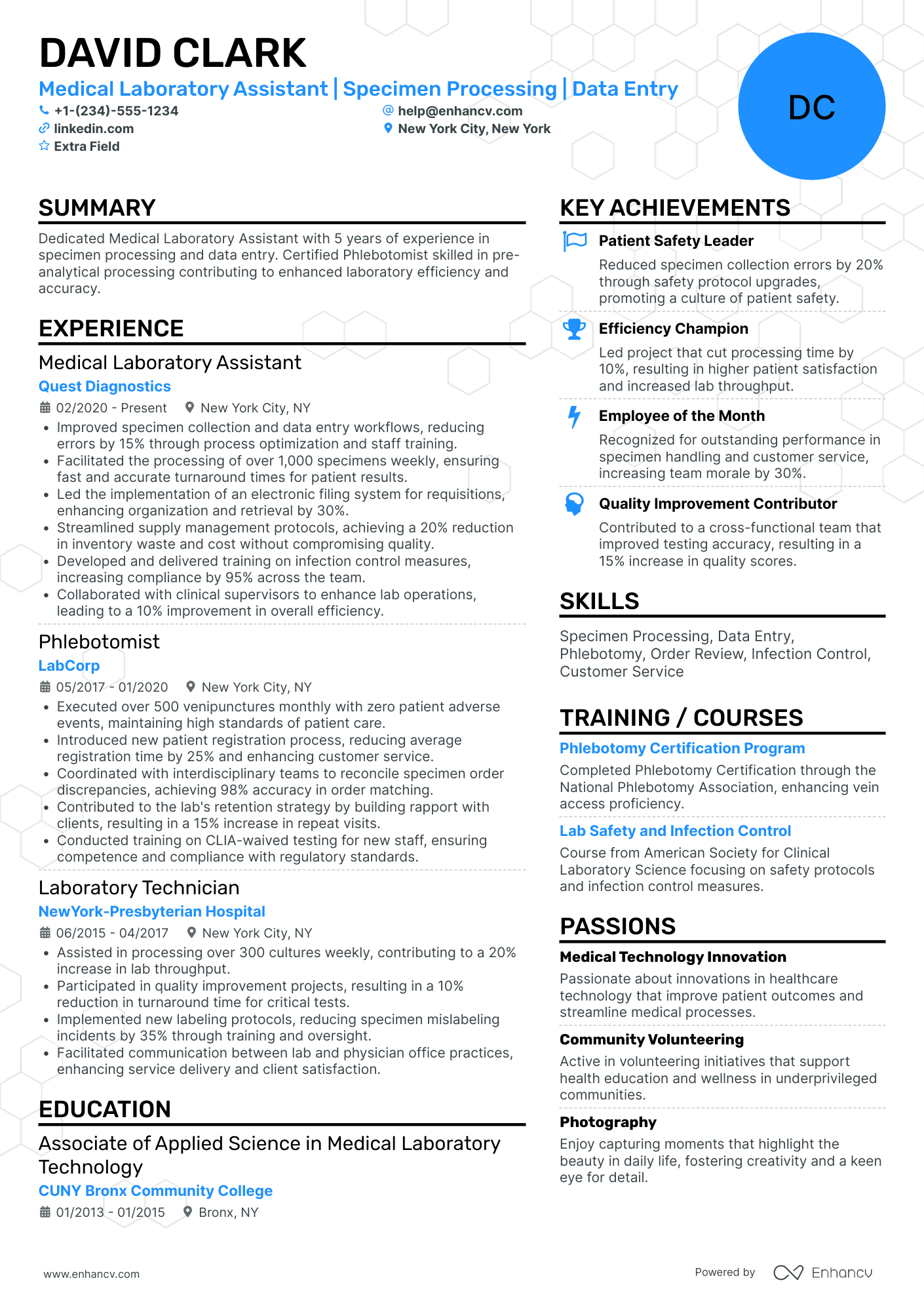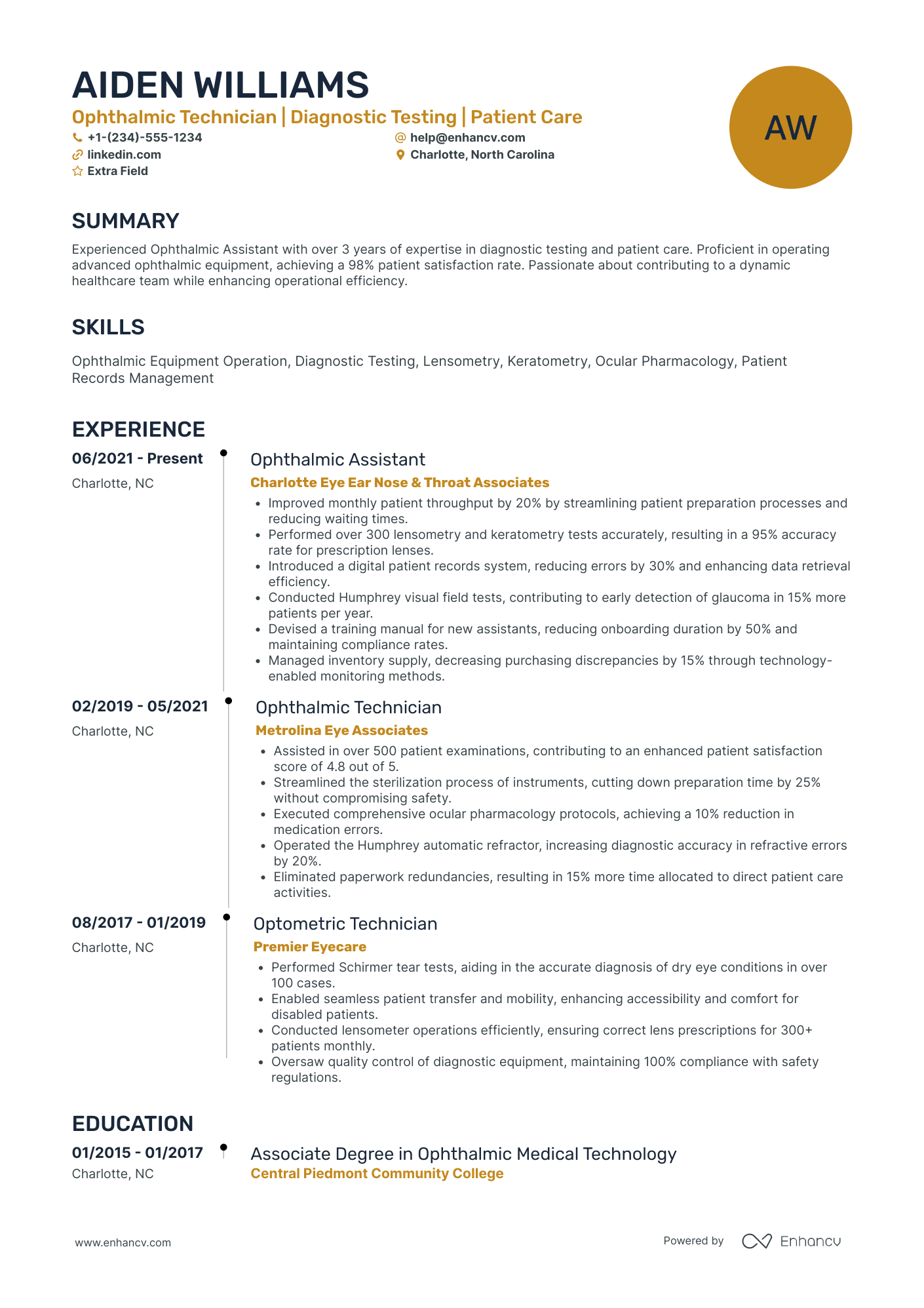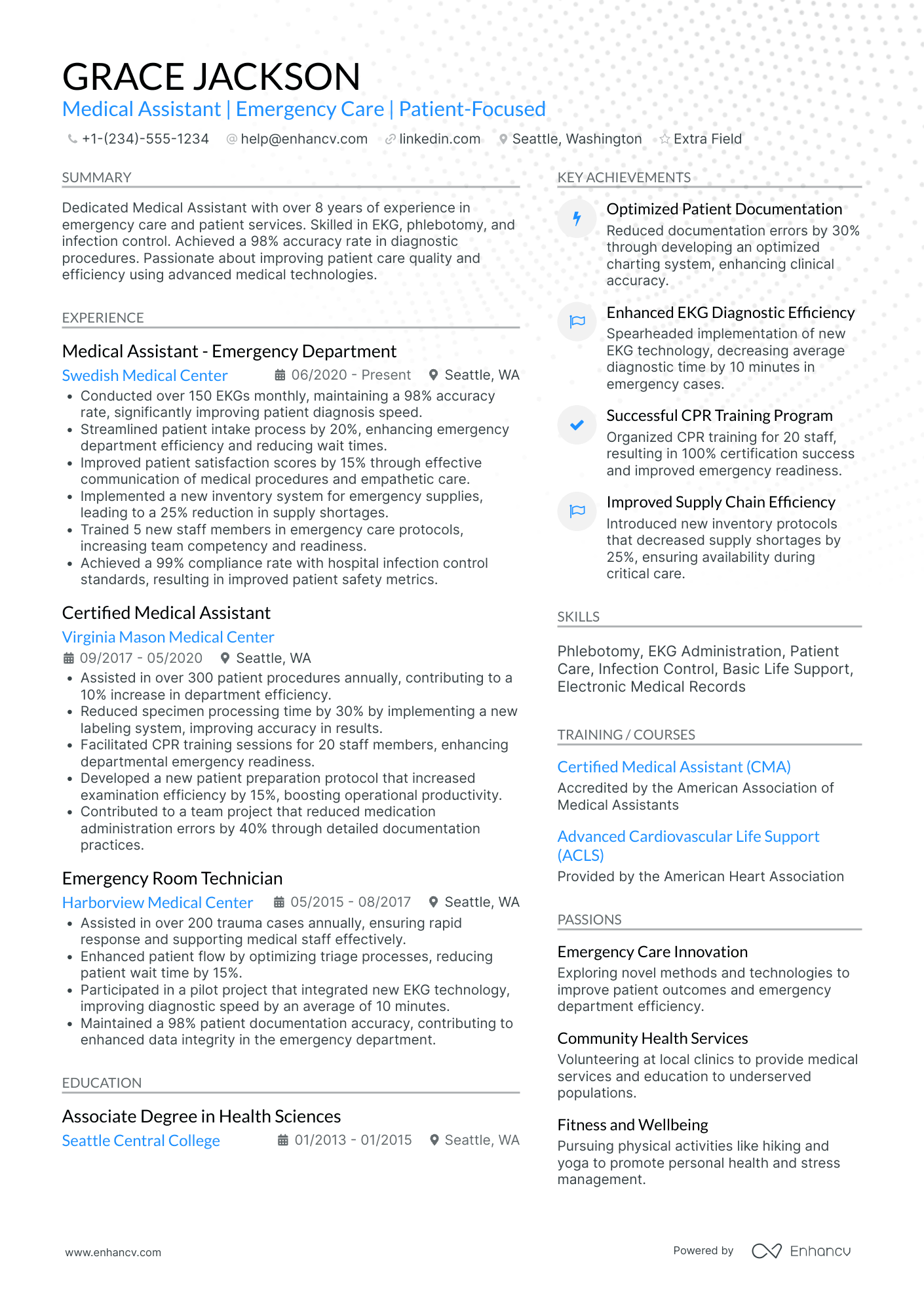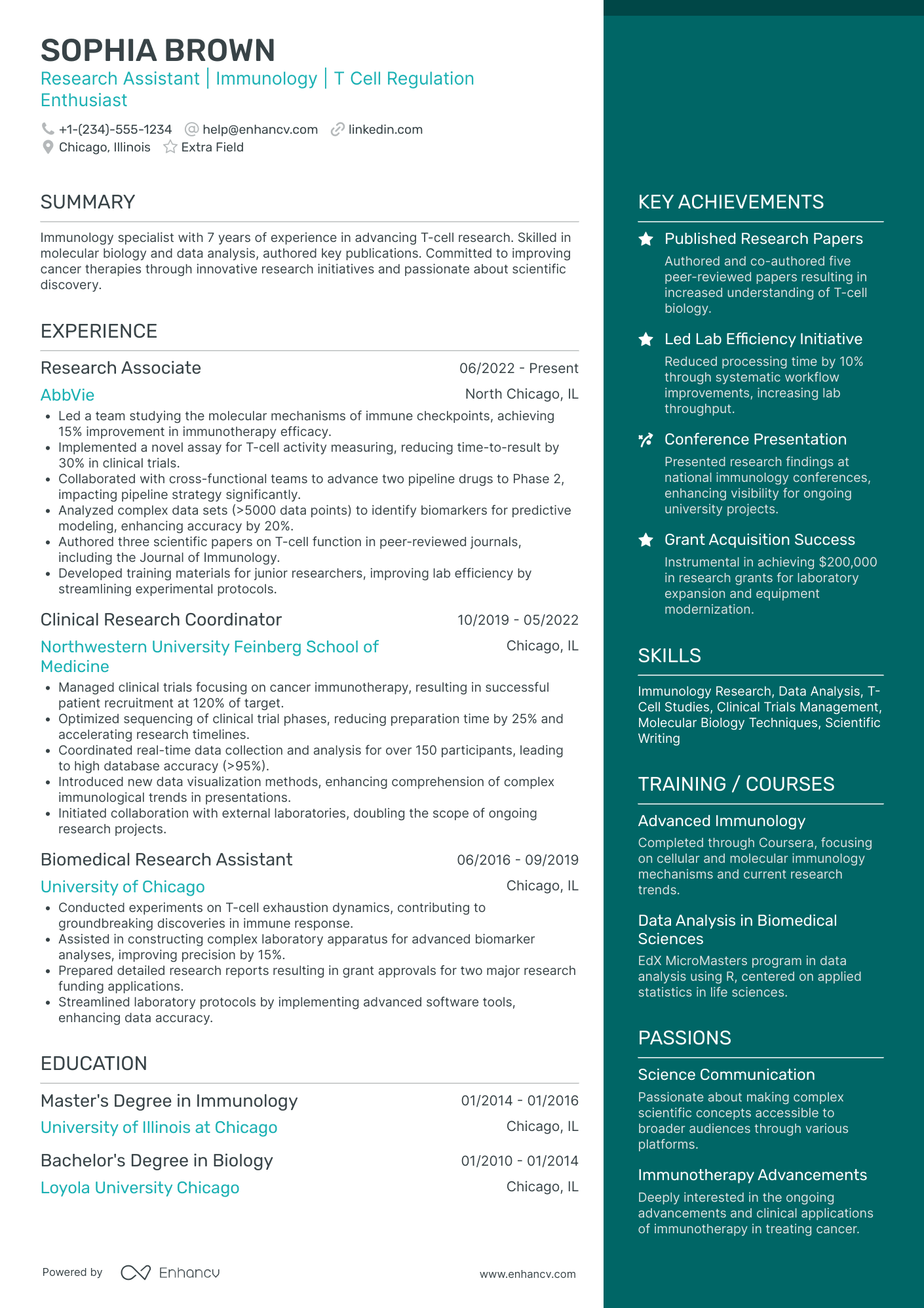The paths to becoming a medical assistant are numerous and varied. Some enter the profession via formal education programs, like degree programs or certified medical assistant (CMA) programs. Others have significant experience but lack formal training. And since employers commonly offer on-the-job training, some enter the field with no prior experience but a strong desire to learn.
As a result of these numerous paths and because there is no mandated degree or licensure, knowing what to put on your medical assistant resume and how to highlight your most relevant qualifications can pose a challenge. Our guide is designed to help you address those challenges and altogether create a beautiful resume that will result in interview callbacks. Here’s what you’ll learn:
- How to showcase your varied duties and responsibilities across specialties and offices on your resume.
- Which medical assistant certifications and training programs to highlight on your resume.
- How best to demonstrate your expertise through your resume regarding your medical assistant specialization.
- Key terms to include on your medical assistant resume for Applicant Tracking Systems (ATS) optimization
- Writing a resume demonstrating your potential for success in the role without direct medical experience.
Medical Assistant resume examples
By Experience
Medical Assistant Intern
Senior Medical Assistant
Entry Level Medical Assistant
Lead Medical Assistant
Medical Assistant Supervisor
Advanced Medical Support Assistant
Medical Assistant Manager
Experienced Medical Assistant
By Role
Pediatric Medical Assistant
Dermatology Medical Assistant
Certified Medical Assistant
Orthopedic Medical Assistant
Medical Assistant Instructor
Medical Laboratory Assistant
Ophthalmic Medical Assistant
Emergency Department Medical Assistant
Medical Research Assistant
How to format a medical assistant resume
Your medical assistant resume is your first opportunity to demonstrate your technical skills in creating well-formatted, easy-to-read documents, a task you may be asked to perform as part of your medical assistant duties.
When formatting your medical assistant resume, be sure to consider the following best practices to ensure you maintain a well-organized professional appearance that is memorable to employers:
- Creative elements: Include creative elements, such as colors, decorative patterns, or a header photo, to make your resume unique and memorable.
- Header content: A prominent header featuring your name, desired job title, and contact information lets employers view them at a glance.
- Ordering: List all section examples in reverse chronological order to ensure your most recent and relevant appear first.
Understanding the role of Applicant Tracking Systems (ATS), especially if you haven't been in the job market for many years, is critical. ATS analyzes text on resumes, looking for exact keywords or phrases corresponding to desirable skills and qualifications for a particular job.
Employers use these systems to sort and prioritize resumes so they can quickly view resumes of the most qualified candidates.
Since medical assistants' qualifications can vary drastically, keeping ATS in mind as you format the information on your resume is vital. Good formatting enables ATS to accurately recognize and parse information from your resume, improving the likelihood of it reaching the employer.
Review these best practices for ATS-optimized formatting on your medical assistant resume:
- Fonts: Select ATS-friendly fonts matching the overall style of your resume. Some ATS-friendly fonts are Serif, Sans-serif, Arial, and Times New Roman. However, these commonly used fonts can be dull or generic. For more creative font options, try Rubik, Lato, Montserrat, Raleway, Exo 2, and Volkhov, which are all available on the Enhancv Resume Builder.
- Document type: Doc or PDF files are typical for resumes and most easily analyzed by ATS.
- Creative elements in text: Avoid using nonessential stylistic features within text. Elements such as emojis and non-standard date formats can impede ATS' ability to recognize information in these sections.
- Headings and subheadings: Ensure resume sections are logically organized and include simple, precise headings. Standard section titles ensure ATS accurately recognizes and extracts information from these sections.
Different markets have specific resume formats – a Canadian resume could vary in layout.
Is your resume good enough?
Drop your resume here or choose a file. PDF & DOCX only. Max 2MB file size.
To improve the probability your medical assistant resume is reviewed, include the following top-recommended sections,
The top sections on a medical assistant resume:
- Certifications: Showcase relevant medical certifications, vital for some specialties.
- Clinical experience: Highlight hands-on medical procedure skills essential to patient care.
- Technical skills: Detail expertise in medical software and equipment, crucial for efficiency.
- Education: Illustrate academic training and foundational knowledge in medical assisting, important for providing proper care.
- Communication skills: Demonstrates ability to interact effectively with patients and teams, key for daily operations.
While applicants may have unique backgrounds and qualifications, there are some skills and abilities commonly sought by employers and recruiters. Be sure to include the following top skills and abilities within the sections of your medical assistant resume:
What recruiters want to see on your resume:
- Clinical skills: Recruiters prioritize proficiency in clinical tasks, as they are central to patient care.
- Administrative skills: These are vital tasks to maintaining records and running an office efficiently.
- Technical abilities: Knowledge of medical software and equipment is crucial for efficient operations.
- Communication skills: Effective interaction with patients and staff is essential for smooth workflow.
- Certification and licensure: These are often mandatory for legal and professional standards.
- Adaptability: Handling diverse tasks and situations is key in dynamic medical environments.
How to write your medical assistant resume experience
The experience section of your medical assistant resume isn’t just your opportunity to share your previous jobs related to the available position. It’s an opportunity to share specific skills and abilities you developed and achievements made in these positions.
The high demand for medical assistants and the broad range of clinical and administrative tasks required means applicants come from diverse backgrounds with varied experience levels. This can make it challenging to determine which employment experiences are most relevant to the position you are applying for.
The best way to determine which work experiences to include on your resume is to create a targeted experience section by selecting your experiences that best align with the available position.
PRO TIP
To quickly and easily create a targeted medical assistant resume for each application, follow these steps:
- Create a resume template including a complete list of your experiences, certifications, education, and skills.
- Make a copy of the template for each new application.
- Review the job description for each new job you apply to, paying close attention to the ideal candidate description.
- In the copy of the template, delete all examples that don't align with the job description.
- Edit remaining examples to ensure they include keywords directly copied from the job description for increased ATS optimization.
One common mistake made in the experience section of medical assistant resumes is simply listing duties performed instead of highlighting what skills you developed or achievements you accomplished. By describing these, you demonstrate not only what you did but how successfully you did it.
Take a look at how the following experience example is improved by focusing on achievements rather than duties.
- •Provided assistance to doctors by rooming patients, obtaining medical history, creating orders, entering procedures into EHR.
- •Applied braces/casts.
- •Prepared and replenished exam room stock each day.
- •Answered patient and inter-office messages throughout day.
While an employer may be able to infer what skills and knowledge it required to complete these duties, it may be unclear. Additionally, this leaves little room to describe or quantify how well you performed these tasks or what you achieved.
- •Developed office-wide HIPPA compliance protocols.
- •Implemented an office-wide, patient-centric communication strategy.
- •Created and implemented a streamlined system to track room restock materials.
- •Streamlined the appointment scheduling process, reducing patient waiting times by 20% utilizing EpicSystems.
In this excellent experience example, the focus shifts from the tasks completed to the skills developed and achievements made. For example, instead of simply stating they restocked rooms, they explain how they implemented a system to make the process more efficient. They also incorporated a particular office management software to demonstrate their technical knowledge and include a keyword skill from the job description.
How to quantify impact on your resume
You can boost the impact of your resume by including quantifiable evidence of your skills in your experience descriptions. Using quantifiable evidence means including tangible, measurable, or verifiable details highlighting your accomplishments in past jobs. Such as:
Sharing a percentage increase in efficiency or patient satisfaction, like this example from the experience section above, is an excellent way to quantify impact. However, you may not always have access to the data necessary to provide specific statistics. Luckily, you can quantify your skills in past roles in many ways.
Here are a few other options for using numbers and data to quantify your skills in your experience descriptions:
- Stating the number of patients assisted daily demonstrates efficiency and capacity to manage a fast-paced environment and large workload.
- To highlight your diverse skill set, note how many medical procedures you are proficient in performing.
- Identify the size of medical teams you've worked with to indicate your experience collaborating as a team member.
- Detail the number of medical reports or records you've managed to showcase your ability to organize and maintain high volumes of patient data.
- Share how many software programs you're proficient in to emphasize your technical acumen.
- State the number of training sessions, workshops, and certifications completed to show your commitment to professional development and continued learning.
- Mention reductions in wait times or operational costs you contributed to illustrate your efficiency and attention to detail.
When including numbers and statistics on your medical assistant resume, remember to be selective, including only the most relevant information. For example, an employer looking to hire someone knowledgeable in medical software would be more impressed by the number of software programs you are proficient in than how many medical procedures you can perform.
How do I write a medical assistant resume with no experience
Thanks to the high demand for medical assistants, some employers offer applicants on-the-job training or certification assistance. So, landing a medical assistant job without prior experience isn’t necessarily a problem.
However, there are some things to remember when writing your medical assistant resume with no experience.
Follow these steps to write your experience section without prior medical assistant experience:
- Compile a list of keywords from the job description.
- Brainstorm previous employment, educational, or volunteer experiences showcasing the same keyword skills and knowledge from your list.
- To add credibility, include tangible evidence of transferable skills, such as certifications and quantifiable data.
- Avoid including irrelevant work experiences or outdated experiences.
- List experiences in reverse chronological order to ensure your most recent and relevant examples appear first.
PRO TIP
For those without medical assistant experience, your cover letter is an excellent opportunity to offer further detail about past jobs and describe how skills and knowledge acquired outside the field are transferable to the open position.
Remember, without direct experience as a medical assistant, the purpose of your experience section is to share related jobs or jobs requiring transferable skills, especially those in the medical field. Therefore, your experience section should still be targeted to a particular position to highlight your potential to be successful in the available position.
How to list your hard skills and soft skills on your resume
The skills section of your medical assistant resume should include subsections for hard and soft skills. The particular skills required of a medical assistant typically vary greatly depending on factors like the size of the office, patient demographics, number of employees, and medical specialty.
For example, an urgent care facility, seeing many patients daily and often only treating once, will value skills such as expansive general medical knowledge and the ability to handle a fast-paced work environment. On the other hand, a small oncology office, seeing patients repeatedly for treatment, will appreciate specialized, in-depth medical knowledge and skills related to compassionate patient care and education.
Hard skills are skills necessary to perform a particular job. They typically require study, training, and practice. In the medical field, they may even require certification. These skills usually relate to technical abilities, such as using office software and equipment or performing medical procedures, such as taking vitals or doing preliminary patient exams.
Here are some of the top hard skills sought by employers looking to hire medical assistants:
Best hard skills for your medical assistant resume
Clinical
- Patient care
- Vital signs measurement
- Phlebotomy
- Injections administration
- Wound dressing
- Laboratory testing
- Diagnostic equipment usage
- Medical terminology
- Sterilization techniques
- CPR certification
- X-ray operation
- Specimen collection
- Anatomical knowledge
Administrative
- Electronic health records (EHR)
- Medical coding
- Medical billing
- Scheduling software
- Prescription processing
- Medical office management
- HIPAA compliance
Soft skills are intrinsic, personal skills related to how you work. These skills are transferable from one position to another because they are part of your personality or personal identity. For example, in the medical field, skills such as compassion, empathy, and active listening will be highly valued regardless of the healthcare office in which you work.
Best soft skills for your medical assistant resume
- Communication
- Empathy
- Time management
- Problem-solving
- Teamwork
- Attention to detail
- Adaptability
- Stress management
- Interpersonal skills
- Multitasking
- Organization
- Patient education
- Cultural sensitivity
- Discretion
- Patience
- Initiative
- Compassion
- Conflict resolution
- Professionalism
- Active listening
Follow these steps to write your medical assistant skills section:
- Format your skills section as a simple list without elaboration or examples.
- Differentiate between hard and soft skills by listing them in separate subsections.
- Consider organizing your hard skills further by adding subheadings for clinical skills and administrative skills.
- Target your list for individual positions using keyword skills from the job description.
- Write skills precisely as they appear in the job description to enhance ATS optimization.
- Never lie or exaggerate your skills.
- Check for consistency between your experience and skills sections. List the skills mentioned in the experience section in the skills section, and vice versa.
In general, employers are more willing to offer training in hard skills. However, their intrinsic nature makes soft skills difficult to teach. Therefore, it's essential to tailor your resume's hard skills for each application and to include as many relevant and transferable soft skills as possible.
How to list your certifications and education on your resume
Education and certifications are exceptionally important on medical assistant resumes since there isn't a specific degree or licensure requirement to become a medical assistant. However, many positions, particularly in specialized medical offices, require them.
Your medical assistant resume's education and certifications sections provide evidence of your hard skills and capacity to learn. Additionally, they illustrate soft skills such as a dedication to ongoing education and improvement.
- To write your medical assistant certification section and education section, follow these steps:
- Create separate sections titled “Education” and “Certifications” to allow ATS to parse information from your resume accurately.
- List all degrees and certifications in reverse chronological order, putting your most recent and relevant at the top.
Education Specific:
- For each degree, include the name of the university, its’ location, the dates you attended, and the title of your degree.
- Including your GPA is optional unless the job description specifies a minimum GPA requirement.
- Only include your major and minor if relevant to the desired position or if it provides relevant information about your background. For example, a minor in Spanish may be appropriate. However, a minor in Dance probably isn’t.
Here’s an example of how an education item should look on your medical assistant resume:
Certification Specific:
- Include the name of the certification, the certifying institution, and the year obtained.
- Consider listing certifications under subheadings for "Clinical Certifications" and "Administrative Certifications" for clarity.
- Limit certifications to current, unexpired credentials. For example, if you were certified in CPR four years ago and never renewed, you shouldn't list this since CPR certification is only valid for two years.
- If a certification requires renewal to remain valid, include the date first acquired as well as the most recent renewal date or a "valid through" date. For certifications you have held long-term, this demonstrates soft skills such as organization and responsibility.
- Limit your certifications to only those specifically named or directly related to the required skills mentioned in the job description. For example, if applying for a medical assistant position working remotely for a medical insurance provider, a certification in CPR wouldn't be pertinent.
Here’s an example of how a certification item requiring renewal should look on your medical assistant resume:
Although there is no mandated certification for medical assistants, "82% of medical assistants are certified," according to The National Healthcareer Association's 2023 industry outlook. Consequently, you'll likely require certification to stay competitive in the medical assistant job market.
If you're considering adding a medical assistant certification to your resume, check out one of these highly sought-after by employers.
Best certifications for your medical assistant resume
- Certified medical assistant (CMA) from the American Association of medical assistants (AAMA)
- Certified Clinical medical assistant (CCMA) from the National Healthcareer Association
- National Certified medical assistant (NCMA) from the National Center for Competency Testing
- Registered medical assistant (RMA) from American Medical Technologists
- Specialty Certified medical assistant (SCMA) from the Specialty Certified medical assistant organization
When writing the education and certifications section of your medical assistant resume, the most important thing to remember is to ensure you're selective when deciding which items you include. While some employers may sift through long lists, others will only take a cursory look before determining whether or not your background will suit their needs. Therefore, it's critical to highlight knowledge and training demonstrating your ability to succeed in a particular role in these sections.
How to write your medical assistant resume summary or objective
A summary or objective section, sometimes called "Resume Profiles" or "Personal Statements," allows you to briefly contextualize how the data and facts on your resume correlate to your career progression and goals and how those demonstrate your suitability for the available position.
These sections are particularly critical to medical assistants because it may sometimes be unclear how their background relates to an available position, particularly if they're changing specialties or new to the field.
Regardless of which section you select for your medical assistant resume, your goal is to explain how your experiences and qualifications make you a suitable candidate for an available job.
The difference between a summary and an objective is the focus on either your past experiences or future career goals. A summary describes how your past experiences align with an available job, while an objective illustrates how your future career goals correspond to it.
A summary is preferable for medical assistants with extensive experience well aligned to the available job, for example, in the same specialty. It highlights how your past success indicates your potential to be successful in the new job.
To write a medical assistant resume summary, follow these best practices:
- Highlight your most relevant skills or experiences that directly overlap with the job description.
- Write an impactful description using keywords directly from the job description.
- Be brief. A summary should only be 3-5 sentences.
PRO TIP
Rephrasing specifics from the “Qualifications” or “Ideal Candidate” sections of a job description is a great way to guarantee you mention the skills and qualifications most valued by the employer.
Alternatively, an objectives section is a better option if you don't have experience as a medical assistant or if your background is significantly different from the advertised job. An objective lets you focus on how you plan to use your background and skills to achieve career goals and contribute to the success of the office.
To write your medical assistant resume objective, follow these best practices:
- Describe the type of position you are seeking.
- Share relevant or transferable hard and soft skills that will help you succeed in the position.
- Highlight your motivation to learn and gain experience while making valuable contributions to the office.
- Use keywords directly from the job description.
- Be brief. Keep your objective to 3-5 sentences.
Diversity among medical assistant responsibilities means most will elect to write an objective section to indicate how their indirectly related experiences imply their suitability. It's vital to detail how you hope to contribute to the office in addition to how the position will help you reach your career goals.
Check out how the following objective is improved by shifting their focus to skills the applicant can utilize to add value to the office.
This is an example of a resume objective that missed many opportunities to include specific keywords and skills by allowing their lack of direct experience to overshadow the skills and knowledge they can contribute. Failing to include details, such as certifications or technical expertise working with medical software or equipment, they overlooked an opportunity to share what they will contribute to the office as they learn and gain experience.
This objective example does an excellent job explaining the skills they will contribute using keywords such as bilingual, CPR certification, administrative expertise, high-quality patient care, and pediatric care. While this individual may not have prior experience working as a CMA, it's evident they've performed similar duties in a medical facility. They explicitly state they hope to utilize these skills in the available position while gaining experience in pediatric care.
Additionally, they provide an excellent example of quantifying their experience in a fast-paced office by stating the average number of patients served daily.
Additional sections for a medical assistant resume
In addition to the top-resume sections, consider including one or more of these optional resume sections to highlight specific qualifications or accomplishments that will help you stand out among the other medical assistant applicants.
- Languages: Excellent patient communication is a cornerstone of the medical field. Therefore, speaking multiple languages is a valuable asset in patient-centric medical environments. Including a language section is an effective way to set yourself apart from other applicants.
- Achievements and awards: If you've received recognition for your work in the past, consider including an awards and achievements section as evidence to support your stated soft skills. For example, an award for excellent patient care or for being a top employee demonstrates a commitment to excellence in your work. In addition to individual awards, you can include awards your office or team received, such as being voted top healthcare facility in your community.
- Volunteer experience: Include related volunteer experiences, especially if you lack experience working in the medical field. For example, if you are applying for a position in a geriatric care facility, sharing an experience volunteering at an active aging center is a great way to demonstrate your background with this patient demographic.
- Professional associations: A professional Associations section highlights your dedication to ongoing improvement and staying current in the medical field. If you would like to include a professional association membership to your resume, consider joining one of the leading professional associations for medical assistants listed below.
Professional associations for medical assistants
These prominent professional associations for medical assistants provide resources, support, and opportunities for networking and continuing education:
By Individualizing your resume with tailored sections you will ensure it reflects all your top qualifications and stand out among other applicants. Should you choose to include sections other than those above, be sure they use catchy, ATS-friendly headings.
How to write a specialization section
If you have extensive experience or certification in a particular medical specialty that directly corresponds to the position you're applying for, consider including a specialization section to highlight your qualifications.
Your medical assistant specialization section should include the following:
- The title of your medical assistant specialization
- Specialty-specific training or certifications
- Specialty-specific medical billing and coding experience
- Technical skills related to software used for medical records, sharing records, reporting statistics, state reporting mandated reporter
- Knowledge and experience of typical medical procedures and equipment used in the specialty
- Relevant soft skills, for instance, compassionate patient education and care in an oncology setting.
Here is an example of how your specialization section should appear on your resume:
While a specialization section demonstrates knowledge, skills, and qualifications, it should only be included as a unique section if applying to a similar medical assistant role. For example, the example above would be relevant to a medical assistant position at an ophthalmic office. Otherwise, these skills may be mentioned in the other resume sections, such as the experience section, to demonstrate your capacity to learn specialized skills.
Key takeaways
Creating a strong medical assistant resume involves tailoring it to individual positions. Review these key takeaways to be sure your resume gets noticed by potential employers.
- Target your resume's skills and experiences by including only examples relevant to the available position.
- ATS-optimized formatting helps ensure your resume reaches employers.
- Provide quantifiable evidence of related skills and achievements to demonstrate impact in previous jobs.
- Include both clinical and administrative hard skills as well as transferable soft skills, using precise wording for enhanced ATS optimization.
- List relevant education and certifications to demonstrate your academic knowledge and medical assistant qualifications.
- Give context to the information on your resume by including either a summary or an objective section.
- Use additional sections to showcase relevant skills that don't fit within other resume sections.
- Include a specialization section when your past work as a medical assistant is well aligned with the new one to highlight your expertise.
